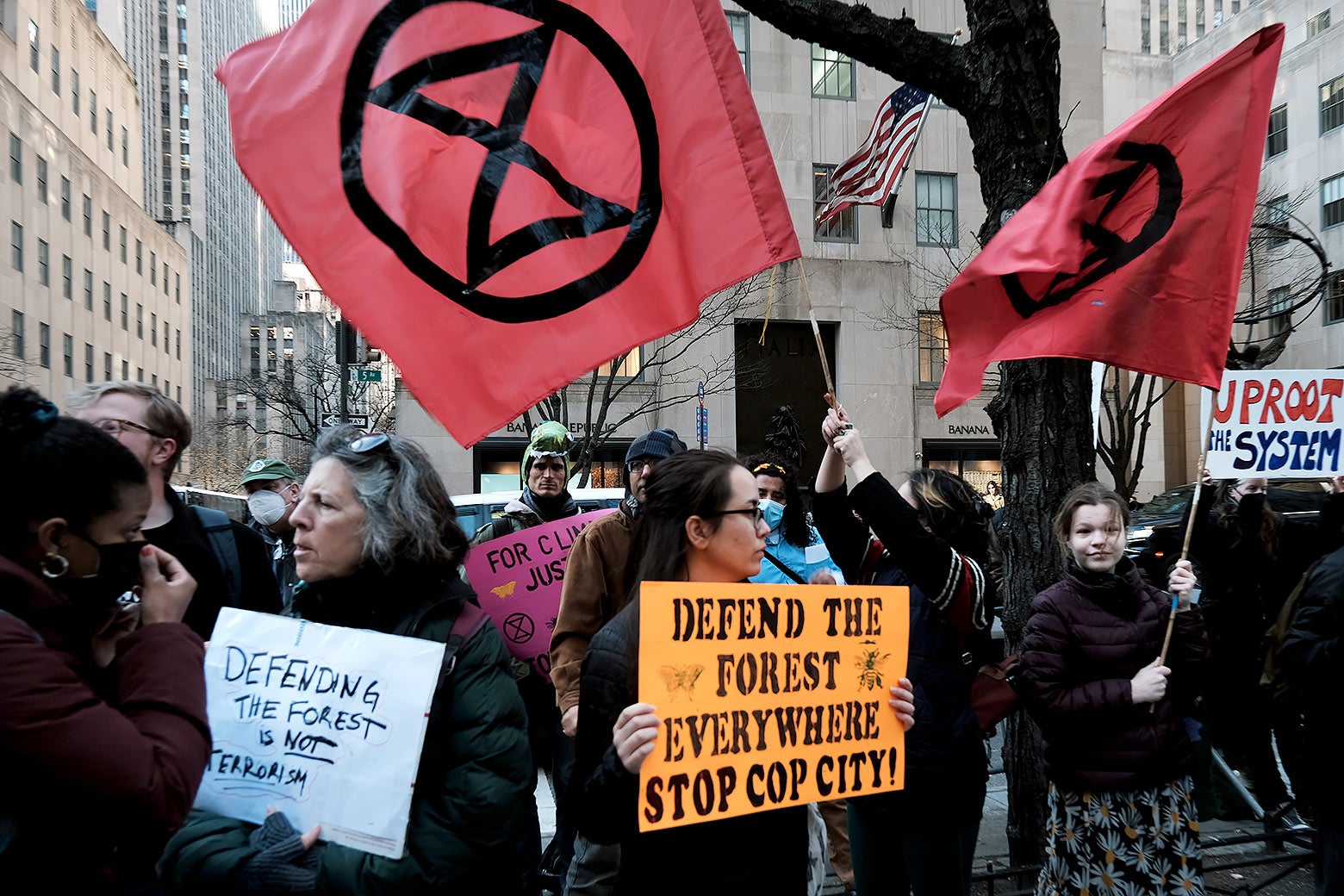Sign up for the Slatest to get the most insightful analysis, criticism, and advice out there, delivered to your inbox daily.
Last week, Dave Wilkinson, CEO of the Atlanta Police Foundation, took the witness stand in an Atlanta courtroom and argued that a local media outlet had no right to request his organization’s records under Georgia’s Open Records Act. Why? Because, he claimed, their coverage of the controversial police training facility known as “Cop City” would be used to turn the public against the project and “terrorize” the companies building it. In other words, the highest-paid police foundation executive in the country essentially argued that journalism is a form of terrorism.
Wilkinson was in court responding to a lawsuit filed by the Atlanta Community Press Collective, a small nonprofit newsroom, and Lucy Parsons Labs, a transparency-focused research organization. The case represents more than just a fight over meeting minutes: It’s a battleground for the future of transparency in public-private partnerships, where private actors are increasingly embedded in state functions—and using that status to shield themselves from public scrutiny.
At the heart of the lawsuit is a critical question: Can the actions of the Atlanta Police Foundation—a private nonprofit—be considered public for the purposes of Georgia’s Open Records Act? The plaintiffs argue yes, pointing out that APF runs nearly two dozen programs on behalf of the city of Atlanta, including the construction of Cop City—a sprawling, militarized police training facility in a metro Atlanta forest—and the development of the city’s surveillance infrastructure. These are not peripheral projects; they are central to how public safety in the city is shaped and enforced. As such, they should be subject to the same transparency standards that govern public agencies. If the court sides with the foundation and allows its refusal to comply with records requests to stand, it could set a dangerous precedent—paving the way for governments to outsource core public functions to private entities shielded from public scrutiny.
The story of Cop City is both deeply local and intensely emblematic of national trends. From its inception, the facility faced widespread public opposition, including mass protests, forest defense occupations, and hundreds of hours of oppositional public comment. It also faced accusations of secrecy and deception, thanks in large part to its funding model: a public-private partnership, or P3. The proliferation of P3s across the U.S.—from transit to housing to policing—has accelerated over the past decade. These partnerships are often sold as “innovative,” but in practice they obscure decision-making, shift risk onto the public, and prioritize profits over public good. In infrastructure, that might mean a toll road built to maximize fees rather than access. In policing, it means a militarized force bankrolled by the private sector to protect capital, not communities.
Originally, the city of Atlanta promised to contribute $30 million in public funds, with the remaining $60 million to come from private donors, funneled through the Atlanta Police Foundation. So, what is a police foundation?
The short answer: a slush fund for police departments. The longer answer: Police foundations are the preferred vehicle for corporations and wealthy donors to bankroll the expansion, militarization, and surveillance capacities of police—outside of public budgets and beyond public oversight. Found in most major U.S. cities, police foundations fund everything from the very serious (the construction of training centers and surveillance networks and the purchase of military-grade equipment) to the kind of inane (sponsoring a police horse, or buying police dogs bulletproof vests, or, in St. Louis, funding the integral work of Operation Polar Cops, an ice cream truck run by police officers.) The donors are often a who’s who of local corporate elites, often with business before the city. So while police already consume the lion’s share of most municipal budgets, they also enjoy a second funding stream that comes with even fewer strings attached.
Independent outlets in Atlanta like ACPC have stepped into a local reporting vacuum during the lengthy Cop City showdown. The city’s flagship newspaper, the Atlanta Journal-Constitution, showed little interest in investigating the project. The reason may be structural: The AJC is owned by Cox Enterprises, a major donor to the Atlanta Police Foundation through the James M. Cox Foundation. Its CEO at the time, Alex Taylor, was directly involved in APF fundraising. Despite claiming editorial independence, the AJC failed to disclose this conflict while publishing favorable coverage and opinion pieces supporting Cop City.
ACPC, by contrast, used Georgia’s open records law to uncover critical facts about the project’s ballooning cost and secretive planning process. Its reporting revealed that the city quietly introduced an ordinance—later passed—that would increase public spending on Cop City to at least $51 million. That included a $31 million payment to the APF, plus a lease-back agreement worth another $20 million over 20 years. These revelations likely wouldn’t have come to light without records obtained through Georgia’s transparency laws.
ACPC had initially accessed APF board meeting minutes by requesting them from the Atlanta Police Department—a public agency that was receiving the minutes from the foundation. But when APF stopped sending those minutes to the Atlanta Police Department, ACPC began requesting them directly from the foundation. APF refused. That stonewalling landed them in court.
This might seem like a narrow skirmish over bureaucratic documents, but the implications are wide. In court, the Atlanta Police Foundation argued that it is a private entity, separate from the Atlanta Police Department, and therefore not subject to Georgia’s open records laws. But the APF’s role in the construction of Cop City—raising the funds, helping select the contractors, crafting communications strategy—looks very much like a public function cloaked in private legal status.
This case echoes a troubling national trend: private actors increasingly exercising public power while avoiding public accountability. Consider Elon Musk’s involvement in everything from federal transportation contracts to national security satellites. His companies shape policy and infrastructure in ways that affect millions, but as private enterprises, they operate outside of most transparency laws. That kind of shadow governance, enabled by P3s, friendly legislators, and a gutted regulatory state, is not a bug of modern governance. It’s becoming the system itself.
At the same time, across the country, state legislatures are quietly but deliberately weakening the open records laws that make investigative journalism possible. Lawmakers are introducing bills that narrow what qualifies as a public record, extend response times, raise fees for requesters, or exempt entire categories of information from disclosure. In some states, public agencies are allowed to simply ignore requests without consequence. In others, journalists have been sued or even criminally investigated for pursuing records. These efforts don’t usually make national headlines, but they are part of a sustained erosion of the public’s right to know—death by a thousand paper cuts to the First Amendment. The result is a chilling effect on accountability reporting and a growing opacity in the very institutions meant to serve the public. In the era of Trump 2.0, as power is increasingly concentrated and privatized, the deliberate dismantling of transparency laws isn’t just a bureaucratic issue, it’s a democratic crisis.
Without access to documents, data, and deliberations, journalism becomes guesswork, speculation, or PR. Reporters can’t hold power to account if they’re forced to work in the dark. If journalism is democracy’s rough draft, as the saying goes, transparency is the paper it’s printed on. This case is about much more than a few withheld emails or board minutes. It’s about whether the public has a right to know how power operates—and who is paying for it—when that power wears both a badge and a corporate logo.

